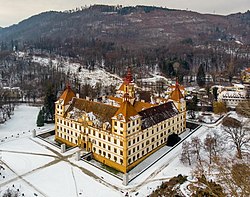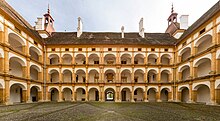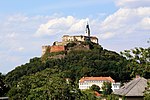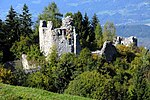Eggenberg Palace, Graz
| Eggenberg Palace | |
|---|---|
SchlossEggenberg(in German) | |
 Aerial view in January 2019 | |
 | |
| General information | |
| Type | Palace |
| Architectural style | GothicandBaroque |
| Location | Graz,Styria,Austria |
| Coordinates | 47°04′26″N15°23′29″E/ 47.07389°N 15.39129°E |
| Elevation | 365 m (1,198 ft) |
| Current tenants | Palace State Rooms, Alte Galerie, Coin Collection, Roman Stonework Collection, Archaeology Collection |
| Construction started | after 1460 (medievalsection), 1625 (Baroqueexpansion) |
| Completed | c. 1635(structure), 1685 (accouterments), 1762 (piano nobile) |
| Cost | over 105,000guilder |
| Client | Universalmuseum Joanneum |
| Owner | The State of Styria |
| Height | 50 m (164 ft) (central tower) |
| Dimensions | |
| Diameter | 65 m x 80 m (palace footprint) |
| Other dimensions | 90,000 m² (palace grounds) |
| Technical details | |
| Floor count | 3 |
| Floor area | 8,000 m² |
| Design and construction | |
| Architect(s) | Giovanni Pietro de Pomis |
| Other designers | Hans Adam Weissenkircher(court painter) |
| Official name | City of Graz – Historic Centre and Schloss Eggenberg |
| Type | Cultural |
| Criteria | ii, iv |
| Designated | 1999(23rdsession) |
| Reference no. | 931bis |
| Region | Europe and North America |
| Extensions | 2010(34thsession)included Schloss Eggenberg |
| References | |
| |
Eggenberg Palace(German:Schloss Eggenberg) inGraz,is the most significantBaroquepalace complex in the Austrian state ofStyria.[1]With its preserved accouterments, the extensive scenic gardens, as well as some special collections from theUniversalmuseum Joanneumhoused in the palace and surrounding park,SchlossEggenberg ranks among the most valuable cultural treasures ofAustria.Eggenberg Palace is situated at an elevation of 381 meters on the Western edge of the city.[2]Its architectural design and the still visible imprint of centuries of history continue to bear witness to the vicissitude and patronage of the one-time mightiest dynasty in Styria, theHouse of Eggenberg.
In 2010, the significance of Schloss Eggenberg was recognised with an expansion to the listing of theGraz Historic Old Townamong theUNESCOWorld Cultural Heritage Sites.
Surrounded by walls, with a huge portal facing West, the palace is located in theEggenbergdistrict of Graz and can be reached bytram.The northern corner of the palace grounds features the Planetary Garden andLapidariumof Roman stonework as well as the entrance to the new Archeology Museum,[1]which houses theCult Wagon of Strettweg.At ground level, the palace houses anumismaticcollection (Coin Cabinet)[3]located in the former rooms ofBalthasar Eggenberger,owner of the imperial minting license and operations in theLate Middle Ages.On the upper level, the Alte Galerie[4]encompasses a large array of paintings, sculptures, and other works of art from themedievalera through theearly modern period,spanning five centuries of Europeanart history.
History
[edit]

Construction
[edit]At first glance, Schloss Eggenberg presents itself as a uniform, new construction of the 17th century. Nevertheless, large portions of the building date back to theLate Middle Agesand construction continued throughout theearly modern era.
Before 1460Balthasar Eggenberger,financier toFrederick III, Holy Roman Emperor,bought property in the west of Graz which became a fixed noble residence in the family name. In the subsequent years the family residence was constructed and expanded. By 1470, a square Gothic chapel had been constructed in the tower. APapalindulgencefrom 30 May 1470 refers to the "Capella Beate Marie Virginis Sita in Castro Eckenperg",the Chapel of the Virgin Mary in Eggenberg Castle, which became the nucleus of the new palace built by Balthasar's great-grandson,Hans Ulrich von Eggenberg.[5]
The younger cousin of GeneralRuprecht von Eggenberg,Hans Ulrich, as a superb diplomat and statesman, steered the foreign policy of his Emperor,Ferdinand II,[6][7]while Eggenberg's counterpart and political adversary,Cardinal Richelieuof France, guided that of KingLouis XIII[8][9]duringThirty Years War.As prime minister (in contemporary political jargon)[10]and close, personal confidant ofFerdinand II,Hans Ulrich wanted a grandiose residence representing his new status and authority when he was named "Gubernator" (Governor) ofInner Austriaafter the emperor choseViennaas his imperial capital.[11]In 1625 PrinceHans Ulrich von Eggenbergcommissioned court architectGiovanni Pietro de Pomiswith the planning of his new palace, inspired byEl Escorialin Spain.[12]As an architect, painter, andmedailleur(designer and minter of medals), de Pomis, originally from Lodi near Milan, became the most important artist at the Grazer court.[13]Incorporating the original medieval family residence into the new palace, de Pomis himself oversaw the construction work up to his death in 1631. Fortress master builder Laurenz van de Syppe continued the work for two years until the building was finished, in the end, by both of de Pomis' site foremen, Pietro Valnegro and Antonio Pozzo. The shell appears to have been completed by 1635 or 1636. Between 1641 and 1646 work on the ornamentation was brought to a close.
In 1666, Johann Seyfried von Eggenberg, grandson of Hans Ulrich, began to develop the palace according to the splendor and grandeur of the Baroque style and in 1673 the residence again entered the limelight asArchduchess Claudia FelicitasofTyrolwas a guest in the palace on the occasion of her wedding in Graz toLeopold I, Holy Roman Emperor.[14]Under Prince Johann Seyfried, the comprehensive cycle of ceiling coverings of approximately 600 paintings in the rooms of thepiano nobilewas accomplished in just 7 years.Hans Adam Weissenkircherbegan his service as the court painter of the princely Eggenberger court in 1678. He finished the painting cycle of the main festival hall, the famous Planetary Room, in 1684/85. With this, the first phase of accouterment work on Schloss Eggenberg was completed.
After the extinction of the male line of theEggenberg family,the Eggenberger state rooms were left in a half-emptied and neglected state. The husband of the last Eggenberger princess, Johann Leopold Count Herberstein, ordered a comprehensive renewal of the complex.[15]Between 1754 and 1762 the building and the garden underwent their second major phase of ornamentation, this time in complete accordance with the tastes of theRococo.Above all, the accouterment of the piano nobile was modernized. Nevertheless, the Planetary Room and the entire cycle of ceiling paintings remained almost unchanged. Thus, the works limited themselves to wall decorations, stoves and pieces of furniture. In keeping with the taste of the times, three East Asian cabinets were introduced and the state rooms received new wall coverings. The most extensive change was probably the demolition of the Eggenberger palace theater, in the place of which abaroquepalace church was established. The supervisor of these works was the Grazer court architectJoseph Hueber,a student ofJohann Lukas von Hildebrandt.
The third phase of the changes came during the 19th century and was limited to the living quarters on the 1st storey (2nd floor in American English) of the palace. Thepiano nobileremained untouched and unused for a full century. The primary focus of attention of this period was the total transformation of the Baroque formal garden into a romantic landscape garden after the English fashion.
The entire complex remained in the possession of the Herberstein family up to 1939. Shortly before the war, Schloss Eggenberg was acquired with the park by the state of Styria. The oldest museum in Austria, theJoanneum,which was established on 26 November 1811 byArchduke Johann of Austria,took over management of the palace and park. TheJoanneumconducted extensive restoration work to repair the damage that occurred during World War II and the subsequent occupation by theAlliesand in 1953 Schloss Eggenberg and the Eggenberg Schloss Park were finally opened again to the public.
Scheme
[edit]With his new residence,Hans Ulrich von Eggenberg,the mental inspiration behind the complex program, realized an architectural concept deeply influenced by the humanist notions of magic as the praxis of natural philosophy and of the rational order of the world. Above all, astronomy, astrology and alchemy were major components of the education of a worldly prince. In addition to representing the prince's new rank, all these aspects flowed into the vision of the new building as a symbol of thecosmosas a well-organized,hierarchical,logico-mathematically explicable system.
Schloss Eggenberg relies on theGregorian calendaras a basis for this constructed universe. The palace has 365 exterior windows, one for each day of the year. Of these, 52 are on the 24 rooms of thepiano nobilerepresenting the weeks of one year. The 2nd storey contains these 24 state rooms in a ring-shaped arrangement which symbolize the hours in a single day. Every floor in the building bares exactly 31 rooms counting the maximum number of days in a calendar month. The 52 windows of the piano nobile with the 8 windows of the Planetary Room make a total of 60, representing both the number of seconds in a minute and the minutes in an hour.
The palace is erected on a rectangular plan with the geometrical center being formed by the middle tower with itsGothicchapel. On each corner there is a tower-like rise. Each of these corner-towers represents one of the four seasons and the outside corner of each is aimed exactly in a cardinal direction.
Planetary Room
[edit]
The cycle of 24 state rooms culminates in the main festival hall, the Planetary Room and serves as both the beginning and the end of the ring of state rooms. The cycle of the oil paintings in this hall was created byHans Adam Weissenkircherand displays the four elements, the 12 signs of theWestern zodiacand of course the sevenclassical "planets"(planetes asteres: wandering stars) known toAntiquity.The cycle of paintings by Weissenkircher melds the architectural program with the ornamentation of the palace thereby achieving anallegoryof the "Golden Age" ruled over by theHouse of Eggenberg.
Piano nobile
[edit]
The cycle of some 600 ceiling paintings in the 24 state rooms of the piano nobile recalls the history of the world with scenes fromGreekandRoman mythology,religious scenes from theOld Testament,and historical legends from Western Europe. This ceiling program with its stucco framing dates back to the first period of accouterment in the 17th century.
Under the married couple Eggenberg-Herberstein, the 24 rooms of the piano nobile were refurbished according to the tastes of the Rococo starting in the mid-18th century. In addition to new pieces of furniture,chandeliersandsconces,and high-qualityfaïencestoves,nearly all the rooms also received brand-new, monochrome silkdamaskwall coverings. Five rooms in the north tract of the piano nobile were equipped with large painted canvasses. Styrian artistJohann Anton Baptist Raunacherdedicated each room to a different subject; shepherd's games, theatrical scenes and gambling scenes are found alongside society scenes and hunting scenes in Schloss Eggenberg. It was during this phase that the Eggenberg palace theater was converted into a palace church in the Baroque style. In addition, three exquisite East Asian cabinets were integrated into the sequence of rooms. The first two are adorned with valuableImari porcelainplates and bowls as well as Chinese silk paintings. In the wall coverings of the third cabinet, eight panels of a precious Japanesefolding screenhave been used. These traditional dividers portray the palace and the fortified town ofOsakabefore 1615, whereby it can be determined that these panels were executed shortly thereafter. From the early modern era there are very few of these screens depicting the city before its destruction, so these works are especially noteworthy. On account of the viewpoint on Osaka the Eggenberg panels represent a unique exhibit.[16]
The find of the screen created a sensation in Japan, since any visual remnants of the time of Hideyoshi were rare. During the state visit of the Austrian president in 2009 amemorandum of understandingwas signed creating a partnership between Eggenberg andOsaka Castle.[17]
-
Main façade with entry portal
-
Garden side of the Palace
-
Planetary Room
-
Piano Nobile
-
Gallery Room
-
Gambling Room with wall coverings by J.A.B. Raunacher
-
Japanese Cabinet with the rare screen depicting Osaka
Gardens
[edit]

The various owners and builder-owners have always looked at the palace and at the surrounding gardens as corresponding elements. Thus, every succeeding generation has carried out significant alterations.
The largest expansion of the garden occurred after the completion of the house. In the last third of the 17th century the garden was generously extended around the building. It followed the pattern of the strictly subdividedItalian garden,withparterres,bosquetareas, fountains,aviariesandpheasantgardens.
Johann Leopold Count Herberstein allowed the whole arrangement to be reshaped into aFrench garden.As early as the 1770s, the Eggenberg Gardens were an attraction open to the Grazer public.
However, with the advent of theEnlightenmentand the liberalization of ideas underJoseph II, Holy Roman Emperor,by the end of the 18th century, it was thought that Baroque gardens were ugly; having a pruned nature constricted by too stringent norms. Jérôme Count Herberstein, as a fanatical garden lover, partook of this perspective and in 1802 prompted the stylish transformation of the Eggenberg Schloss Park into a picturesqueEnglish garden.[18]labyrinths,fountains, straight paths and hierarchical patterns all had to give way to the call to "return to nature" in the sense ofJean-Jacques Rousseau.Apart from the straight entrance way, which was preserved, the goal was to create artificial vistas with the new, winding pathways and the illusion of being in an Arcadian landscape painting such as those ofClaude Lorraine[19]whose works inspired the likes ofStourheadas well as many others. The recently restored Rose Mound formed the climax of this 19th-century landscape park.
The early 20th century saw a dwindling of interest in the palace gardens and the Eggenberg Schloss Park no longer employed a gardener. This had the unfortunate consequences of individual elements of the garden being torn-out and, over the course of decades, the rest being overgrown; the entire arrangement thus becoming more or less a simple city park.
In 1993, in cooperation with the Austrian Federal Bureau ofCultural Heritage Management(Bundesdenkmalamt), a garden grooming project was begun with the goals of preserving and reconstructing the gardens as a cultural monument toRomanticism.The still existing elements were to be made recognizable and protected and the lost elements reconstructed in so far as it was possible. The initial phases of this project that have already been completed are the reconstruction of the 1848 Breakfast Garden behind the palace and the reclamation and restoration, which occurred during the winter months of 2007/08, of the Rose Mound, one of the most important components of the romantic English landscape garden.
Additionally, thepeacocksfrom the Graz Peacock Garden formerly located between the inner city and the city park have found a new home in the Eggenberg Schloss Park. The species are of both the white variety and the more common Indian blue peacock. During mating season, the loud cawing of the males as well as their brilliant plumage adds an exotic flair to the splendor of the park as they try to attract the larger but less colorful females.
Planetary Garden
[edit]
In the north corner of the grounds, an enclosed, separate garden went through such diverse transformations and uses over the course of the palace history that in the end it was discernible only by the spatial structure.
Due to a lack of surviving records, a new design for the flower garden was decided on in 2000 and a new garden grew out of an old idea.Landscape architectHelga Tornquist took up the theme of the Eggenberg scheme and incorporated it into a contemporary garden creation. This reclamation takes up in a playful fashion the ancient system of planetary "signatures", which is of special significance for theiconographyof Schloss Eggenberg.[20]The Lapidarium has been established over the foundations of the formerorangeryas a point of interest and to provide an appropriate setting for theRomanStonework Collection of the Joanneum.
Schloss Eggenberg enters the 21st century with the opening of a newly constructed subterranean showroom adjoined to theLapidariumto house the Joanneum'sPre- and Early HistoryarchaeologicalCollections in autumn of 2009 to be ready for the Joanneum'sbicentennialcelebration in 2011.

Commemorative silver euro coin
[edit]In 2002, theAustrian Minthonored the importance of Schloss Eggenberg, by using it as the main motif of one of its most popularsilver euro commemorative coins:the10 euro Eggenberg Palace commemorative coin.The reverse side shows an image ofJohannes Kepler,a personal acquaintance of Eggenberg's[21]who taught at the former Protestant school in Graz. His first major work,Mysterium Cosmographicumdescribing the Copernican system, written while he was still in Graz, likely influenced the symbolism of the design of the palace.[21]
See also
[edit]Notes and references
[edit]- ^Das Joanneum – Österreichs Universalmuseum.2006
- ^Eggenberg Palace Elevation and Location
- ^"Coin Cabinet Schloss Eggenberg".Joanneum.Retrieved6 October2019.
- ^"Alte Galerie Schloss Eggenberg".Joanneum.Retrieved6 October2019.
- ^Becker, U. "The Eggenberg Altarpiece" inSchloss Eggenberg.Graz: Christian Brandstätter Verlag, 2006, p. 14.
- ^Schloss Eggenberg.2006, p. 43.
- ^The Thirty Years War.1961, p. 60.
- ^The Thirty Years War.1961, p. 183.
- ^Schloss Eggenberg.2006, p. 105.
- ^Die Fürsten und Freiherren zu Eggenberg und ihre Vorfahren. 1965, p. 90.
- ^Schloss Eggenberg.2006, p. 97.
- ^Schloss Eggenberg.2006, p. 98.
- ^Schloss Eggenberg.2006, p. 86.
- ^Schloss Eggenberg.2006, p. 68.
- ^Schloss Eggenberg.2006, p. 204.
- ^Ôsaka zu byôbu. 2010, p. 8.
- ^"Universalmuseum Joanneum GmbH".Archived fromthe originalon 30 October 2023.Retrieved17 October2023.
- ^Schloss Eggenberg.2006, p. 259.
- ^Schloss Eggenberg.2006, p. 262.
- ^Schloss Eggenberg.2006, p. 284.
- ^ab"Eggenberg Palace coin".Austrian Mint. Archived fromthe originalon 31 May 2011.Retrieved9 September2009.
Sources
[edit]- Das Joanneum – Österreichs Universalmuseum[documentary film DVD] By Günther Schilhan (director) & Helmut Gesslbauer (producer), Austria: ORF Steiermark, 2006. (available through the Joanneum)
- Schloss Eggenberg.By Barbara Kaiser. Graz: Christian Brandstätter Verlag, 2006.ISBN978-3-902510-80-8(English Edition) orISBN978-3-902510-96-9(German Edition) (available through the Joanneum)
- Planet Eggenberg.By Hermann Götz. Graz: Landesmuseum Joanneum / Leykam Medien AG, 2005.
- Ôsaka zu byôbu: Ein Stellschirm mit Ansichten der Burgstadt Ôsaka in Schloss Eggenberg.inJoannea Neu Folge, Band 1.By Franziska Ehmcke et al. Graz: Universalmuseum Joanneum, 2010.ISBN978-3-902095-32-9(available through the Joanneum)
- The Thirty Years War.By Cicely Veronica Wedgwood. Garden City, NY: Anchor Books, 1961. (Re-issued by NYRB Classics, 2005.ISBN978-1-59017-146-2)
- Hans Ulrich Fürst von Eggenberg: Freund und erster Minister Kaiser Ferdinand II.By Hans von Zwiedineck-Südenhorst. Charleston, SC: BiblioBazaar, 2009. (new edition of digitally preserved original German text printed in Vienna in 1880, printed in Leipzig by Amazon Distribution GmbH)ISBN978-1-113-02782-5
- Ein Staat in Alt-Österreich: Besitzungen der Eggenberger.By Franz Kammerhofer. Graz: Franz Kammerhofer, 1998.ISBN978-3-9500808-1-0
- Die Fürsten und Freiherren zu Eggenberg und ihre Vorfahren.By Walther Ernest Heydendorff. Graz: Verlag Styria, 1965.
- Alte Galerie – Masterpieces.By Ulrich Becker et al. Graz: Landesmuseum Joanneum, 2005. (English edition)ISBN978-3-7011-7533-8
- Der Eggenberger Altar.By Paul W. Roth et al. Vienna, Austria: Österreichische Galerie Belvedere, 2001.
- Schloss Eggenberg: Lernbehelf für Guides.By Barbara Kaiser. Graz: Landesmuseum Joanneum, 2001.
- Hans Adam Weissenkircher: Fürstlich Eggenbergischer Hofmaler.By Barbara Ruck. Graz: Landesmuseum Joanneum, 1985.
- Giovanni Pietro de Pomis.By Kurt Woisetschläger et al. Graz: Verlag Styria, 1974.ISBN978-3-222-10847-1
External links
[edit]- Castles in Styria
- Parks in Austria
- Gardens in Austria
- Buildings and structures in Graz
- World Heritage Sites in Austria
- Archaeological museums in Austria
- Art museums and galleries in Austria
- Numismatic museums in Austria
- Tourist attractions in Graz
- Houses completed in 1646
- Historic house museums in Austria
- Museums in Graz
- 1646 establishments in the Habsburg monarchy
- 17th-century establishments in Austria
- History of Graz
- Baroque palaces in Austria
















